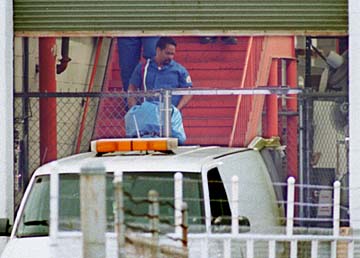

XEROX SHOOTINGS


NOT since John Miranda taped a shotgun to a hostage on Sand Island in 1996 has Hawaii seen such horror in the workplace.
But unlike Miranda -- who was the only fatality of his dramatic rampage over a lost job -- yesterday's carnage brought a national nightmare to Hawaii's doorstep.
The unexplained employee-on-employee attack at the Xerox offices on Nimitz Highway left seven workers dead.
"People here are used to being behind the mainland in most trends, but this is one area where we're not that far behind," said Dr. Shepard Ginandes, a Honolulu psychiatrist who deals mostly in work-related stress.

"There are a lot of people out there who are angry or stressed out because of their jobs."Ginandes, who is seeing increasing levels of job-related stress among his patients, was not surprised by yesterday's attack.
"I knew it would sooner or later appear in its mainland form," he said. "It was only a matter of time."
Byran K. Uyesugi, the 40-year-old suspect in yesterday's killings, has offered no motive.
National statistics show more than 1,000 homicides in the workplace each year. But fewer than 100 of them are committed by co-workers, according to the National Institute for Occupational Safety and Health.

The institute, part of the Centers for Disease Control and Prevention, identifies high-risk occupations among the majority of victims, including police officer, taxi driver and convenience store clerk.Despite intense media attention in recent years, murder among co-workers is relatively rare.
Gary Farkas, a Honolulu psychologist who counsels companies on violence prevention, notes that suicide in Hawaii is much more common than murder.
But while the workplace is relatively safe, a worker predisposed to violence can be pushed over the edge by a loss, real or perceived, Farkas said.
"It might be the loss of a job or some perceived entitlement," he said.
While experts debate trends in workplace violence, many agree on some common denominators. Among them: substance abuse, anti-social behavior and stress.
Larry J. Chavez, senior hostage negotiator at the Sacramento Police Department, described the typical workplace killer as "a male, asocially-isolated loner, who is either a disgruntled employee, an angry client, a sexual harasser, an irate spouse or a jilted would-be lover of one of your employees."
Anthony Marsella, a University of Hawaii professor of psychiatry, saw yesterday's tragedy as a warning that both Hawaii and the nation should be doing more to develop programs to detect and prevent workplace violence.
"What we are seeing is a critical issue for our society to deal with," Marsella said. "The question is, are we recognizing these early warning signs?"
Ginandes said a change in Hawaii's workers compensation law two years ago may be adding to the problem.
"Any workmen's compensation lawyer will tell you that almost all stress-related claims are now denied by insurers," he said.
Employees who complain to their employers of stress-related injuries are usually turned away, forcing them to file a claim at the state Department of Labor -- another exercise in frustration, Ginandes said.
"Unfortunately, the trend in recent years has been away from the injured worker and toward the insurance companies," he said.
Marsella said Hawaii's faltering economy must also play a part as stress builds because workers fear they will be laid off and won't be able to find another job.
Finally, the easy availability of guns in American society is part of the problem, Marsella said.
"Are we creating a community that raises the stress level and increases the high levels of frustration? What about those living lives of quiet desperation in borderline jobs?" Marsella asked.
Ginandes had some advice for employers.
"Hire the best-qualified people to take care of your human resources program and employee assistance programs," he said. "Then listen to them and accept their advice."